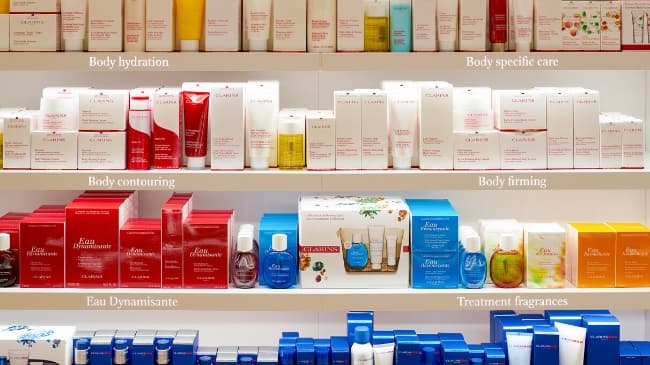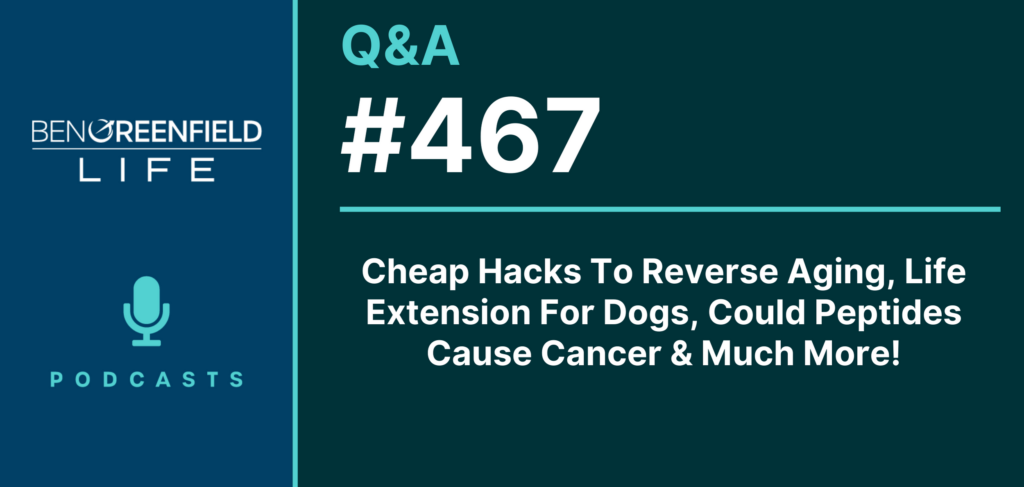February 18, 2020
I've always said that abs are made in the kitchen (and certainly sculpted with a few specific exercises), but what many people don't realize is that abs can be lost in the bathroom (and not in the way you think)…
What exactly does this mean?
Common personal care products contain ingredients that can undermine health in various ways. We absorb much of what we put on our skin, including endocrine-disrupting chemicals like xenoestrogens that can reduce testosterone.
In today's article—a guest post by Katie Wells, aka the “Wellness Mama,” who was recently on my podcast “Water Fasting, Trauma Release For Fat Loss, Homeschooling, Hidden Nasty Ingredients In Your Personal Care Products & Much More With Katie Wells TheWellnessMama!“—you'll discover how the ingredients in these common personal care products can sabotage your health…and yes, your abs too. You'll also learn the top 10 ingredients to look out for when shopping for cosmetics.
Hidden Ingredients That Sabotage Your Health
A few years ago, I noticed a disturbing trend: several of my close friends who ate clean and avoided the most harmful household products were still using conventional personal care products. When asked, they explained that it was because these products worked, and they hadn't found cleaner natural options that were as effective.
Most of us are well versed in the bad ingredients to avoid in food, but hidden ingredients in products we use on our body can be just as problematic.
A 2009 study found 287 chemicals in babies' cord blood, and this number goes up as children grow. In adults, the amount can be much higher, and many of these chemicals are linked to congenital disabilities, lower testosterone, impaired sleep, and other problems.
Avoiding the most offensive ingredients can help reduce exposure by over 80%. This was my motivation in creating the first line of completely safe and independently verified products that work better than conventional products.
Doesn’t the FDA Have It Covered?
It’s a common misconception that skincare ingredients must be proven safe and effective before they’re allowed on the market.
Even worse, the FDA doesn’t have the authority to ban skincare ingredients that show strong evidence of being dangerous or deadly.
Talcum powder is one perfect example.
Products that contain talc (aka talcum powder) include makeup and baby powder. Talcum powder is frequently contaminated with cancer-causing asbestos and recent court proceedings have found that one major company knew this for decades. Millions have already been paid in damages and the lawsuits just keep rolling in (so far there are 15,500 lawsuits).
You'd think this would be enough to pull these products from shelves, right? Nope. Baby powder is still sold in stores, still being sprinkled on baby’s genitals, and still causing harm for some. The FDA and government oversight agencies usually don’t pull the plug on ingredients like this, so it's up to us as consumers to choose safe products.
Enter “greenwashing.” Many companies have caught on to the fact that consumers want safe, natural products for their families. While this is driving positive change, not everything is as it seems. Since the beauty industry is largely self-regulated, skincare companies can dress up labels with natural-looking colors, terms like vegan and all-natural, while still hiding a bunch of toxins in the ingredients list.
Top 10 Ingredients to Avoid in Personal Care Products
It’s hard to narrow this list but avoiding just the ten most toxic personal care ingredients makes a huge difference in exposure. Many products use labels like “natural” or “clean” that are mostly unregulated. Know the most significant offenders to avoid.
While not an exhaustive list by any means, these are the top offenders.
Typically if a product has one of these ingredients (or more), it's a good indication to avoid the product.
1. Artificial Fragrances
While they may smell pretty, masculine, or calming, fragrances hide a dirty secret. A lot of dirty little secrets. Companies aren’t required to disclose the chemicals that make up their fragrances, and sometimes they don't even know.
The chemists who create fragrances have over three thousand chemicals to work with. Many of these fragrance chemicals are derived from petrochemicals that are known allergens and hormone and endocrine disruptors. These toxic ingredients can hide under the terms fragrance or parfum and don’t have to be listed on the label.
Here are products to watch out for that often contain fragrance:
- Air fresheners and scented candles (no, not skincare, but worth mentioning!)
- Perfume, body spray and cologne
- Shampoo and conditioner
- Haircare products
- Body wash, hand soap, and bar soap
- Makeup
- Sunscreen
- Bubble bath
- Face wash
- Makeup remover
- Face treatments and cleansers
- Lotion
2. Petroleum
Petroleum jelly, petrolatum, mineral oil… these are all names for the same ingredient. Often found in lotions and balms labeled “healing” to the skin, petroleum jelly is a highly refined byproduct of the oil industry. Oil companies didn’t want the sludge at the bottom of the oil rigs to go to waste, so it was refined and sold as a skin protectant.
As an oil industry derivative, petroleum is not eco-friendly or sustainable, and it isn’t so skin-friendly either. A 2011 study in the Journal for Women’s health, “Evidence for cosmetics as a source of mineral oil contamination in women,” found petroleum in cosmetics contains toxic hydrocarbons.
The researchers went on to say there’s strong evidence these “mineral oil hydrocarbons are the greatest contaminant of the human body.” The toxins accumulated in the women’s body fat and were also found in their breast milk.
Hydrocarbons and toxins aside, petroleum forms a non-breathable layer on the skin. While this layer locks in skin’s natural moisture, it can also prevent it from healing. Petroleum also dries out and blocks pores.
3. Phthalates
There are over a dozen types of phthalates used in personal care products to improve their fragrance and pliability. Some phthalates have very little or no safety studies to show if they’re harmful, while others are linked with some serious health concerns.
A 2010 article in the journal Alternative Medicine Review, “Toxic effects of the easily avoidable phthalates and parabens,” pointed out some major problems with these chemicals. The scientists at Made Safe also weigh in on the issue.
As known hormone disruptors, phthalates may contribute to certain types of cancers, reproductive toxicity, sperm damage, altered genital development in boys, infertility, testicular dysgenesis, obesity, endocrine system issues, fibroids, and other issues.
You'll find Phthalates in:
- Fragrances and perfumes (see the above list for products containing fragrances)
- Hairspray and hair care products
- Nail polish
- Makeup
4. Parabens
Researchers found this common preservative in virtually all Americans. Parabens can mimic estrogen and cause hormone disruption. A 2012 study in the Journal of Applied Toxicology that measured concentrations of parabens in human breast tissue found that exposure to certain parabens increased the risk of breast cancer and issues with reproduction.
Researchers published a 2019 study in the journal Environmental Science and Pollution Research International that found traces of intact paraben molecules in endometrial carcinoma. In that study, over 23% of the women with cancer had parabens in the diseased endometrial tissue, compared to only 2% in the control group.
Another 2019 study from the International Journal of Hygiene and Environmental Health examined the effect of parabens on birth outcomes. Baby girls born to pregnant women with paraben exposure had significantly lower birth weights.
You'll most often find parabens in deodorant, shampoo, soap, lotion, makeup, shampoo, conditioner, sunscreen and other personal care products.
5. Aluminum
Aluminum is one of the more controversial ingredients on this list since we still don't completely understand how aluminum enters the body through the skin. We do know that aluminum is found in Alzheimer’s patient's brains and is thought to contribute to brain dysfunction, Parkinson’s disease, and neurological disease, according to a 2014 report by the Scientific Committee on Consumer Safety.
Although research has not proven a link between aluminum and specific brain disorders, it IS known to be toxic to the brain. Aluminum is also suspected of playing a role in breast cancer.
It's easy to avoid when we know where to find it, and natural alternatives work just as well. Watch out for aluminum in antiperspirant deodorants, lipstick, toothpaste, and many kinds of makeup.
6. PFOAs, PFCs and Teflon Chemicals
There are thousands of fluorinated chemicals in our food, water, and cosmetics. Known as PFCs or PFASs they were originally intended to replace PFOAs (which are confirmed toxins). The CDC found that these perfluorinated chemicals have already contaminated nearly everyone in the US and they’re now a global problem.
Teflon and PFC manufacturer’s replaced the chemical with a new one they dubbed “GenX.” However, safety studies show it probably isn’t any better.
Rats exposed to GenX Teflon had more preterm births, low birth weights, and delayed puberty. Rats exposed to high doses of the chemical gasped in pain, had seizures, and dropped dead within hours.
Both animal and human studies have linked fluorinated compounds (like PFCs, PFASs, and the phased-out PFOAs) with a laundry list of health issues including, cancerous tumors, kidney disease, liver problems, uterine polyps, immune system dysfunction, and reproductive damage.
Thankfully, these chemicals don't quickly enter the body through the skin, unlike other offenders on this list. When applied around the eyes and mouth, they’re much more likely to enter the body. Unfortunately, PFASs are most often used in eye products and lip products (as well as other cosmetics).
There are well over a dozen PFASs found in cosmetics so it’s impossible to list them all. However, if a product has the letters “fluoro” in the ingredients list, then it’s a perfluorinated chemical. Watch out for these in makeup including eye shadow, bronzer, eyeliner, mascara, lipstick, and blush. You may also find them in moisturizers, eye cream, sunscreen, shampoo, and shaving cream.
7. Vitamin A (Retinyl Palmitate or Retinoic Acid)
Although vitamin A is essential to a healthy body, the synthetic version, retinyl palmitate … not so much. When skin that has been exposed to retinyl palmitate is exposed to sunlight, it may cause skin damage. Some studies have also shown intense skin irritation and sensitivity.
In animal studies, mice rubbed with retinyl palmitate lotion and exposed to UV rays had faster tumor formation. According to a 2012 report from the National Toxicology Program, Photocarcinogenesis Study of Retinoic acid and Retinyl Palmitate, tumors and cell mutation formed at very low doses. The same report warned that high amounts of synthetic vitamin A in cosmetics and food can contribute to birth defects.
Pregnancy Concerns
The Norwegian Scientific Committee for Food and Environment (VKM) have cautioned that skincare products with vitamin A can increase birth defects when used before or during pregnancy.
Women who had more than 4.5 grams a day of Vitamin A from all sources (food, supplements and cosmetics) had a 3.5 times higher risk of giving birth to a child with birth defects than mothers who had only 1500 mg synthetic vitamin A.
Too Much Vitamin A Can Equal Bone Problems
Not only does synthetic vitamin A contribute to skeletal birth defects, but it can contribute to osteoporosis as well. VKM recommends older women and those at increased risk of fracture and osteoporosis should reduce their use of synthetic vitamin A.
According to VKM It’s estimated about 10% of older women exceed the max safe amount of synthetic vitamin A just from food and supplements. Since vitamin A is often found in anti-aging creams, these are more likely to be used by the same group of women they’re most likely to harm.
Watch out for retinyl palmitate or retinoic acid in sunscreen, anti-aging products, moisturizers, liquid foundations, other makeup and shampoo.
8. Polyethylene Glycols and Polysorbate (PEGs)
PEG, the same active ingredient in the popular laxative Miralax, is widely used in cosmetics. There are hundreds of versions of PEG chemicals in skincare products and most are backed by very little to no safety data. However, the biggest concern with PEGs is the toxins they may carry with them.
PEGs are frequently contaminated with 1,4-dioxane. Several health agencies have reported 1,4-dioxane probably causes cancer and it’s been linked with breast cancer and tumors in the liver, gallbladder, nose, lungs, and skin.
Not only do PEGs likely bring along cancer-causing chemicals, but they also enhance the penetration of other potentially harmful chemicals. PEGs are used by skincare formulators to soften and open up the skin's pores to the other ingredients in a product. While this isn’t necessarily a bad thing, any toxins in the product get a free ride through our skin’s barrier thanks to the PEGs.
Keep an eye out for PEGs in makeup, sunscreen, skincare products, lotions, hair gel, serums, shampoo, conditioner, shaving cream, body scrubs, face masks, and more.
9. Triclosan
The FDA spoke out against the antibacterial ingredient triclosan and in 2017 banned its use in certain products, including hand sanitizer and certain soaps.
However, according to the scientists at Made Safe, triclosan is still found in everything from body wash and toothpaste, to clothing and toys. The chemical is thought to contribute to deadly antibiotic resistance and negatively affect thyroid health. Triclosan can damage the endocrine system and reproductive hormone function even at very low doses.
In his 2018 article, Triclosan and Cancer Risk: Is There a Link?, Dr. Kistler references the potential dangers of triclosan. There’s evidence triclosan may play a role in several different types of cancer and the FDA is currently conducting further studies on the subject. Not only is triclosan bad for us, but it’s known to be toxic to water-life.
A 2014 report presented at the American Chemical Society found some disturbing evidence in the pregnant women studied. The researchers found triclosan in all of the pregnant women’s urine samples and in half of the babies' umbilical cord blood.
It was clear triclosan passes from mom to unborn baby potentially leading to severe problems, since there’s growing evidence triclosan can lead to developmental and reproductive issues.
Many manufacturers have phased triclosan out of their products (thankfully!), but still keep an eye out for it in deodorant, toothpaste, mouthwash, soap, lotions, and some types of makeup.
10. Methylisothiazolinone (MIT)
This preservative was named “allergen of the year” by the American Contact Dermatitis Society. Not an award I’d want to win!
Government agencies in Europe, Germany, Japan, and Canada have limited its use because of safety concerns. However, the US doesn’t seem phased, and it’s still widely used here with fewer restrictions than our international neighbors.
MIT is strongly linked with skin sensitization and irritation, the main reason why it is restricted in other countries. A 2002 study in the Journal of Neuroscience, In Vitro Neurotoxicity of Methylisothiazolinone, also found MIT is highly toxic to brain neurons and recommended further safety research.
Watch for methylisothiazolinone in shampoo, conditioner, gel, hair products, sunscreen, foundation, primer, bronzer or highlighter, and many other types of makeup.
Summary
It can be overwhelming and scary to look at lists like this and know that there are thousands more potentially harmful ingredients lurking in our common products.
But it doesn't have to be! Avoiding these top offenders reduces your exposure.
Choose products and brands that avoid these ingredients and that clearly label and test their products. My brand new company Wellnesse (which Ben and I discuss in detail here in this podcast) was founded on this idea of radical transparency, avoiding these and other common harmful ingredients, and independently testing and verifying all products. Their natural toothpaste and haircare products work just as well as conventional alternatives and contain beneficial ingredients to improve hair and teeth over time. Kion Serum is another great option, containing twelve potent, all-natural and organic ingredients that have been expertly blended to help reduce the appearance of wrinkles, improve skin firmness and elasticity, and even skin tone.
And about that old adage, “Don't put anything in your body that you can't pronounce.” I always read the ingredients list on skincare products, but just because I can’t pronounce it doesn’t mean an ingredient is necessarily harmful. For example, alpha-tocopherol may sound like a toxic chemical, but it’s the antioxidant vitamin E. Shea butter is listed as the tongue twister Butyrospermum parkii on skincare labels.
So ultimately, when in doubt, do some research!
Leave any comments, questions, or thoughts you have about personal care products below, and I'll get back to you!














What about Vitamin C? It can also cause skin irritation ;like synthetic Vit A – is it an issue in high doses?
Why did you not mention the natural vitamin A found in many beauty products? Rosehip oil, beta-carotene, alfalfa and bakuchiol are natural vitamin A compounds found in skincare.
re: Fragrance, “Hibiclens” contains it.
This is a full body anti-bacterial scrub that many medical providers (Kaiser Permanente) require before a surgery.
I had severe skin rashes (including oozing pustules) for several weeks after each surgery, no doctor had any idea why.
Eventually a 5-day allergy test showed that I was allergic to “fragrance”.
I have mentioned it to several providers at Kaiser, none took me seriously, or took any action to change this policy. Yes, there are alternative products that probably cost 1 penny more per packet.